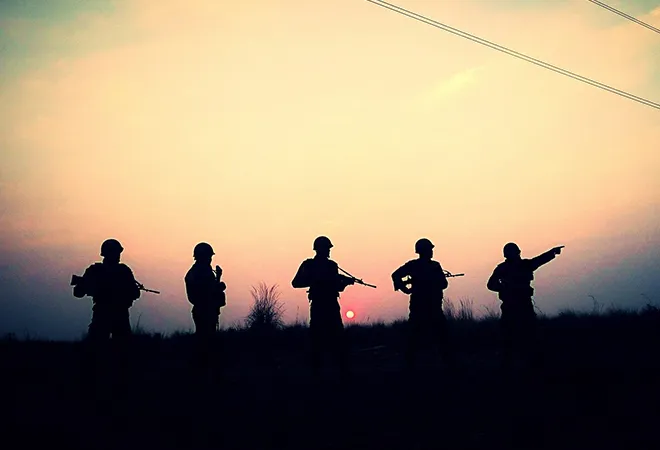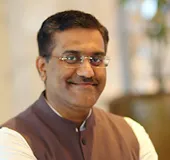
This piece is part of the series, India @75: Assessing Key Institutions of Indian Democracy.
As it completes 75 years of independence, India has emerged as one of the few post-colonial nations with a vibrant democratic polity. When most of its neighbours have failed to maintain their democratic credentials and political stability, India has proved to be sui generis by distinguishing itself from the other former European colonies in terms of the military’s role in the state’s functioning.
In academics, this is described as the ‘civil-military relations’ concept that focuses on managing the relations between the civilian executive and military, two of the most important state organs. This fundamental operating principle defines the limits of power for the two in line with a particular democratic policy. Yet, its implementation in real life has proved complex. As the experience of many democracies worldwide, including in India’s neighbourhood, suggests, the generals have usurped power from the civilians through coups, or the militaries are playing an outsized role in national politics.
But India’s experience is contrasting. The country has followed the sine qua non of civilian supremacy over the armed forces, thereby, minimising the latter’s role in domestic politics. According to the Constitution, the military is answerable to the President of India, its Commander-in-Chief. In practical terms, this is mediated by the Central government comprised of elected representatives who work through the Council of Ministers, committees, and the bureaucracy to deal with the military.
As the experience of many democracies worldwide, including in India’s neighbourhood, suggests, the generals have usurped power from the civilians through coups, or the militaries are playing an outsized role in national politics.
This arrangement persisted even as the military became a critical part of the national psyche and emerged as a powerful actor. It safeguarded India from the misconduct of its adversarial neighbours but also aided the civil authority during crises and critical law and order situations—it is often the first responder in providing assistance to cope with natural disasters.
Post-1947 military reforms
India’s civil-military relations have a colonial legacy. Lord Kitchener won the bureaucratic battle against Lord Curzon, as a result of which the Commander-in-Chief of India occupied a dual position of being the equivalent of the Army Chief and the Minister of Defence. But Prime Minister Jawaharlal Nehru introduced several reforms that did away with this colonial legacy and cast a new mould of civil-military relations.<1>
First among these reforms concerned the post of Commander-in-Chief. During the first interim government in 1946, Nehru kept the Commander-in-Chief out of the Cabinet and insisted that all communications came through the civilians in the Ministry of Defence (MoD). Nehru reformed the higher management of the military by creating Commander-in-Chief positions for the air force and navy as well. This made the Commander-in-Chief of the army “one of the three nominally equal chiefs.” In one stroke, Nehru had eliminated a centre of power in the military, thereby, underwriting the civilian government’s dominance.
Thereafter, assisted by Lord Mountbatten’s aide General Lord Hastings Ismay, the government created a three-tier system.<2> It comprised the Defence Committee of the Cabinet (where Sardar Baldev Singh served as India’s first defence minister), the Defence Minister’s Committee (with the three Commanders-in-Chief, the Defence Secretary and the Financial Adviser) and the Chiefs of Staff Committee (comprising the three Chiefs). In succeeding years, this structure waxed and waned. The bureaucracy succeeded in dropping the title “Commander-in-Chief” for the heads of the three services and made them mere chiefs of staff. This diluted the ability of the political system to get single-point military advice.
Early on, military officials resented the extent of civilian control over their actions, the civilian officials’ lack of military knowledge and their restricted role in national security decision-making.
Secondly, all senior military officers were placed below elected ministers and senior civil servants in the official order of precedence. For instance, a secretary to the government of India, who ranked lower than a lieutenant general before 1947, now became equal to the rank of a full general. Thirdly, Nehru pressed to change the ethnic composition of the Indian Army, which was till then dominated by recruits from Punjab, North-West Frontier Province and other traditional ‘martial’ groups. He wanted to broaden this base to reflect India’s democratic ethos. Nehru was convinced that only then the fledgling Indian democracy could be secured from military interference. Finally, raising the paramilitary forces for internal security duties ensured that the military didn’t get entangled in domestic agitations or civil disturbances.
These steps, in essence, set up the operating conditions for civil-military relations in India for the decades ahead and coup-proofed the Indian democracy. However, early on, military officials resented the extent of civilian control over their actions, the civilian officials’ lack of military knowledge and their restricted role in national security decision-making.
Civilian supremacy in operation
The civilian supremacy over the military continued to expand in subsequent years. Under a 1952 rule, the service headquarters were designated as “attached offices” of the MoD. In 1961, the government introduced a new Allocation and Transaction of Business Rules (AOBR and TOBR).<3> These rules stated that the civilian secretary of the MoD was responsible for “the proper transaction of business” of the ministry, which included “preparation for defence and all such acts as may be conducive in times of war to its prosecution and after its termination to effective demobilisation.”
Many subsequent developments stress-tested this arrangement as the Indian state confronted consecutive security challenges.
The 1962 India-China War was one such challenge when civilian officials were accused of meddling in military affairs. Some also blamed the Nehru government for implementing the infamous ‘Forward Policy’, which weakened the military’s capacity to defend India against Chinese advances. Some counterargued that the military did not prepare enough for all eventualities from the Chinese side. India’s military debacle in this conflict exposed the civilians’ lack of sufficient military knowledge and their tendency to avoid operational matters. As a result, the civilians left the war issues to the military’s consideration, as was evident during the 1965 War, when the military largely conducted the India-Pakistan. This led to its own problems, including the declaration of ceasefire at a time Pakistan was on the ropes.
India’s military debacle in this conflict exposed the civilians’ lack of sufficient military knowledge and their tendency to avoid operational matters. As a result, the civilians left the war issues to the military’s consideration, as was evident during the 1965 War, when the military largely conducted the India-Pakistan.
By this time, another tendency was visible—the civilians consulting the military, apprising them of the political considerations but leaving the specifics of the operational details to them. This was what led to a successful outcome in Bangladesh (1971) but disastrous ones in Operation Bluestar in Punjab (1984) and Operation Pawan in Sri Lanka (1987).
However, even as India upheld civilian supremacy, some critics argued that this supremacy dealt a blow to the military’s effectiveness. Their mutual engagement focused on the process than the outcome. Thus, even as India did not lose any of the wars except the 1962 border conflict with China, its operational performance left much to be desired. Moreover, this arrangement produced a civil-military discord, or ‘absent dialogue’, where the two differed on critical national security goals. For instance, between 2003–2007, the government of the day was promoting peace with Pakistan, while the army was practising doctrines like Cold Start, which sent a contrary signal.
Fixing civil-military relations
Since the Kargil War of 1999, much effort has gone into better organising civil-military relations. The Group of Ministers on National Security in 2001 recommended integrating the civilians and the military in the MoD and creating the Chief of Defence Staff’s (CDS) position. However, the only outcome of this process was the nomenclatural change in renaming the headquarters of the three services as the “Integrated headquarters” of the army, or the navy or air force sans any real integration. Meanwhile, establishing the military/defence wing in the National Security Council Secretariat created another avenue for the military’s involvement in national security thinking and decision-making.
The Modi government has sought to deal with this issue through two separate sets of moves, both aimed at promoting civil-military ties but top-down. One was the creation of the Defence Planning Committee (DPC), headed by the National Security Adviser (NSA), Ajit Doval, which included the three chiefs to “facilitate a comprehensive and integrated planning for defence matters.” The DPC analyses planning in issues like foreign policy imperatives, operational directives, strategic and security doctrines, and defence acquisition and infrastructure. The Integrated Defence Staff was appointed as its secretariat, leaving people wondering whether the system had developed a hybrid CDS system.
The lack of civilian involvement in operational matters as shaped by the experience of the 1960s and 1970s. However, changing threat landscape demands better informed civilian leadership.
But then came the second move, which was the appointment of General Bipin Rawat as the first CDS in 2019 and along with that, to cut the Gordian Knot of the AOBR and TOBR, he was appointed Secretary of a new Department of Military Affairs (DMA) in the MoD. For the first time since 1952, the armed forces were brought into the apex government structure.
The DMA handles the three armed forces, the integrated HQs of the armed forces, the Territorial Army, works relating to the services, procurement except for capital acquisitions, promoting jointness, restructuring military commands etc. However, in a somewhat anomalous manner, all this was laid out in the amendment to the AOBR in December 2019. The Defence Secretary continued to be responsible for India’s defence, and the phrase “including defence policy” was added to the old language of the 1961 AOBR. Additionally, the government clarified that Defence Secretary would continue to be responsible for capital acquisitions. By loosening civilian control and lessening the bureaucratic interference in military affairs, the government has attempted to elevate the military’s profile in the apex structure that deals with defence. Yet, one challenge endures The lack of civilian involvement in operational matters as shaped by the experience of the 1960s and 1970s. However, changing threat landscape demands better informed civilian leadership. Particularly in the nuclear environment, it is important for the political leadership, which alone can authorise the use of nuclear weapons, to be much more involved in operational matters. This firewall between the civilian leadership and military officials in operational matters has to be razed for optimal functioning of civil-military ties in the interest of the nation.
<1> Manoj Joshi, “Managing National Security,” in B.G. Verghese ed. Tomorrow’s India: Another tryst with destiny,” (New Delhi, Penguin/Viking, 2006), 28–29.
<2> Joshi, “Managing National Security”, 30.
<3> R. Chandrashekhar, “Indian Armed Forces in the National Security Matrix: Need for comprehensive integration,” Centre for Joint Warfare Studies, Issue Brief Vol. XII, No. 1 (April 2018).
The views expressed above belong to the author(s). ORF research and analyses now available on Telegram! Click here to access our curated content — blogs, longforms and interviews.




 PREV
PREV



